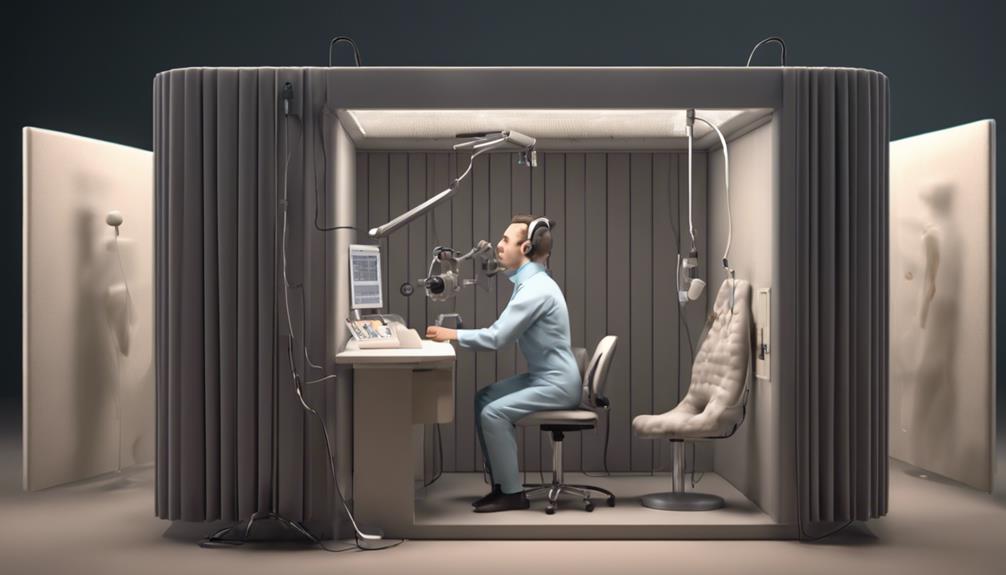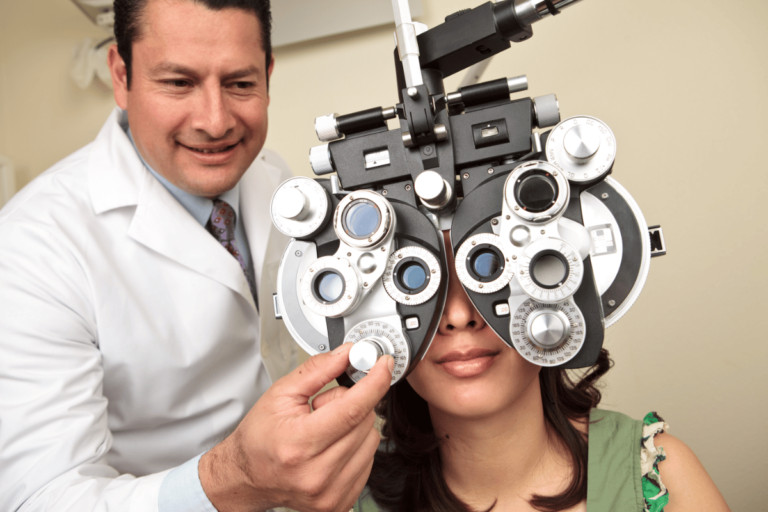Audiologist Job Description
Audiologists hold doctoral degrees, gain practical experience through internships, and prioritize ongoing education. They use diagnostic tests like pure-tone audiometry to evaluate hearing loss. Treatment plans are customized through collaborative goal setting, ensuring thorough care. Personalized options cater to individual needs, aiming for best outcomes. Follow-up care involves counseling, device maintenance guidance, and family involvement. Working with healthcare professionals ensures all-encompassing care. Research advancements drive industry progress. Adherence to ethical guidelines is paramount. Audiologists guide patients through the challenges of hearing loss with empathy and expertise. Explore more about the diverse role of audiologists.
Key Takeaways
- Conduct diagnostic testing to assess hearing abilities and determine treatment needs.
- Develop personalized treatment plans based on individual patient requirements.
- Collaborate with patients to set goals and ensure satisfaction with care.
- Provide follow-up care instructions for device maintenance and progress monitoring.
- Engage in research and stay updated on industry regulations for professional practice.
Educational Requirements
To become an audiologist, individuals must complete an extensive educational journey encompassing a doctoral degree in audiology. This advanced degree is essential for audiologists to acquire the specialized knowledge and skills required to diagnose and treat hearing and balance disorders effectively.
In addition to the academic requirements, audiologists must also fulfill certification requirements to practice professionally. Practical experience is a critical component of their education, often gained through internships or clinical rotations where they work under the supervision of experienced audiologists to apply their theoretical knowledge in real-world settings.
Continuing education opportunities are important for audiologists to stay abreast of advancements in their field and maintain their certification. These opportunities allow audiologists to expand their knowledge, learn about new technologies, and enhance their clinical skills to provide the best possible care for their patients. By engaging in continuing education, audiologists demonstrate their commitment to excellence and ongoing professional development in the ever-evolving field of audiology.
Diagnostic Testing
Audiologists use a variety of diagnostic testing methods to assess and identify hearing and balance disorders in patients. Through thorough hearing evaluations, audiologists can determine the extent and nature of a patient's hearing loss, enabling them to make accurate diagnoses and formulate appropriate treatment recommendations.
Diagnostic assessments may involve pure-tone audiometry, speech audiometry, tympanometry, and auditory brainstem response testing, among other specialized tests. These assessments aid audiologists in developing personalized treatment strategies tailored to each patient's specific needs.
Treatment Planning
Audiologists excel in creating personalized treatment options tailored to each patient's unique needs, ensuring individualized care plans that address specific hearing issues effectively.
By engaging in collaborative goal setting with patients, audiologists foster a compassionate and supportive environment where the patient's preferences and goals are integral to the treatment process.
This meticulous approach allows audiologists to provide thorough care that prioritizes the well-being and satisfaction of those seeking help for their hearing health.
Customized Treatment Options
When developing customized treatment options for individuals with hearing impairments, audiologists meticulously analyze each patient's unique needs and preferences to create tailored plans that optimize their auditory experience. Through effective patient communication, audiologists guarantee that they grasp the specific challenges and goals of each individual.
This process involves detailed assessments of hearing capabilities, lifestyle factors, and personal preferences. Treatment customization is key in providing the best possible outcomes for patients, as it allows audiologists to recommend interventions such as hearing aids, assistive listening devices, or auditory training programs that align with the individual's needs.
Individualized Care Plans
In developing individualized care plans for patients with hearing impairments, meticulous attention is given to analyzing their unique needs and preferences to tailor treatment recommendations that optimize their auditory experience. By focusing on personalized care, audiologists aim to improve patient satisfaction and treatment outcomes. This personalized approach involves a thorough assessment of each patient's hearing condition, lifestyle, and communication goals. Treatment plans are then crafted to address specific challenges and enhance the individual's quality of life. Regular evaluations and adjustments guarantee that the care plan remains effective and aligned with the patient's evolving needs. This patient-centered approach fosters trust and collaboration, ultimately leading to improved outcomes and enhanced satisfaction.
| Key Considerations | Patient Satisfaction | Treatment Outcomes |
|---|---|---|
| Assessment | Tailored to preferences | Enhancing quality |
| Planning | Addressing challenges | Improving results |
| Implementation | Regular evaluations | Monitoring progress |
| Adjustments | Aligned with needs | Ensuring effectiveness |
Collaborative Goal Setting
With a meticulous focus on collaboration and goal setting, treatment planning in audiology involves a detailed and compassionate approach to tailoring interventions that align with each patient's unique needs and aspirations.
Audiologists engage patients in the treatment planning process by employing effective communication strategies to guarantee patient engagement and understanding. By working closely with patients, audiologists can set realistic treatment outcomes that are tailored to each individual's specific needs and preferences.
This collaborative goal-setting approach not only enhances patient satisfaction but also increases the likelihood of treatment success. Through open communication and shared decision-making, audiologists can create personalized care plans that address the patient's concerns while aligning with their treatment goals, ultimately leading to improved outcomes and overall patient well-being.
Hearing Aid Fittings
Hearing aid fittings are vital in ensuring peak functionality for individuals with hearing loss. The process involves an overview of the fitting procedure, discussing the technology options available, and providing detailed follow-up care instructions to promote successful adaptation and usage of the hearing aids.
Audiologists carefully tailor each fitting to the individual's unique needs, emphasizing the importance of personalized care and ongoing support for improved quality of life.
Fitting Procedure Overview
The process of fitting hearing aids involves a thorough evaluation of the individual's auditory needs and physical ear characteristics to guarantee ideal device selection and customization. Audiologists employ fitting techniques to ensure a proper fit, considering patient comfort and best sound delivery.
Communication strategies play an important role in explaining the fitting procedure to the individual, addressing any concerns, and setting realistic expectations for outcomes. Throughout the fitting process, audiologists prioritize patient satisfaction by actively listening to feedback and making necessary adjustments.
In cases where challenges arise, audiologists use troubleshooting techniques to identify and resolve issues promptly, aiming to provide a thorough and effective hearing aid experience for the individual. This all-encompassing approach underscores the audiologist's commitment to enhancing their patient's quality of life through improved hearing.
Technology Options Available
An array of advanced technology options is currently available for audiologists to contemplate during the process of fitting hearing aids, allowing for tailored solutions to meet individual needs and preferences.
Audiologists can now utilize telehealth services and remote programming to assist patients in adjusting their hearing aids from the comfort of their homes, enhancing convenience and accessibility.
Additionally, artificial intelligence plays a significant role in modern hearing aid technology, enabling features like speech recognition that enhance the listening experience in various environments.
These technological advancements not only improve the functionality of hearing aids but also contribute to a more personalized and effective fitting process, ultimately leading to better outcomes for individuals with hearing loss.
Follow-Up Care Instructions
With the technological advancements in hearing aid fitting processes enhancing customization and accessibility, providing thorough follow-up care instructions post-fitting becomes important to guarantee ideal patient outcomes and satisfaction. Post appointment follow-ups and clear patient communication are vital to address any concerns and ensure proper usage. Additionally, offering detailed guidance on hearing aid maintenance and troubleshooting advice equips patients with the necessary skills to manage their devices effectively. Below is a table summarizing key components of follow-up care instructions for hearing aid fittings:
| Follow-Up Care Instructions | Description |
|---|---|
| Post-Appointment Follow-Ups | Schedule check-ins to address concerns and assess progress. |
| Patient Communication | Ensure clear instructions for device usage and maintenance. |
| Hearing Aid Maintenance | Provide guidance on cleaning, battery replacement, and care. |
Patient Counseling
When providing patient counseling as an audiologist, it is essential to approach each individual with empathy and understanding, tailoring the information to their specific needs and concerns.
Communication strategies play an important role in counseling sessions, ensuring that patients comprehend their diagnosis, treatment options, and how to effectively use hearing aids. Audiologists provide emotional support, helping patients navigate the challenges that hearing loss can bring to their lives.
They assist in making lifestyle adjustments to accommodate hearing difficulties, such as recommending assistive devices and communication tactics for different environments. Involving the patient's family in counseling sessions can foster a supportive environment and enhance the patient's overall well-being.
Family members play a critical role in the patient's hearing healthcare journey, understanding the impact of hearing loss on their loved one and learning how to facilitate effective communication. Through patient counseling, audiologists empower individuals to manage their hearing health effectively and improve their quality of life.
Collaboration With Healthcare Professionals
In the field of audiology, effective collaboration with healthcare professionals is crucial for guaranteeing thorough and holistic care for individuals with hearing difficulties. Audiologists work in a team approach, often partnering with otolaryngologists, speech therapists, primary care physicians, and other specialists to provide all-encompassing care to patients. This team-based approach allows for a more in-depth assessment of the patient's needs and ensures that all aspects of their hearing health are taken into account.
Interdisciplinary communication is key in these collaborations, as different healthcare professionals bring unique perspectives and expertise to the table. Audiologists communicate test results, treatment plans, and progress updates with the rest of the healthcare team to guarantee continuity of care. They also rely on input from other professionals to gain a thorough understanding of the patient's overall health and how it may impact their hearing abilities.
Research and Development
Effective advancement in the field of audiology heavily relies on ongoing research and development initiatives to enhance diagnostic tools and treatment options for individuals with hearing difficulties. Innovation strategies play an important role in driving progress within audiology by fostering creativity and new approaches to address challenges in the field.
Audiologists engage in product development through evidence-based research to create cutting-edge solutions tailored to meet the diverse needs of their patients. Clinical trials are conducted to validate the effectiveness and safety of new interventions, ensuring that audiologists stay at the forefront of providing high-quality care.
Through continuous research and development efforts, audiologists aim to improve the accuracy of diagnostic tests, explore novel treatment modalities, and enhance patient outcomes. By staying informed of the latest advancements and participating in collaborative research projects, audiologists contribute to the collective knowledge of the field and drive innovation that benefits individuals with hearing impairments.
Industry Regulations
Traversing the intricate landscape of industry regulations in audiology requires a keen understanding of compliance standards and ethical guidelines. Audiologists must adhere to industry standards set forth by regulatory bodies to guarantee the highest level of patient care and professionalism. Licensing requirements vary by state and country, but typically entail obtaining a doctoral degree in audiology, completing a supervised clinical fellowship, and passing a national examination.
Industry regulations also encompass maintaining proper documentation, ensuring patient confidentiality, and staying up-to-date on advancements in audiology practices. Audiologists must regularly attend continuing education courses to enhance their skills and knowledge, demonstrating their commitment to providing quality care within the boundaries of established regulations.
Conclusion
To sum up, audiologists play a vital role in diagnosing and treating hearing disorders through a combination of diagnostic testing, treatment planning, and hearing aid fittings.
Their collaboration with healthcare professionals, dedication to patient counseling, and commitment to staying updated on industry regulations guarantee quality care for individuals with hearing impairments.
As audiologists navigate the complex landscape of auditory healthcare, they serve as beacons of hope in guiding patients towards improved hearing and quality of life, like lighthouses in a sea of uncertainty.







